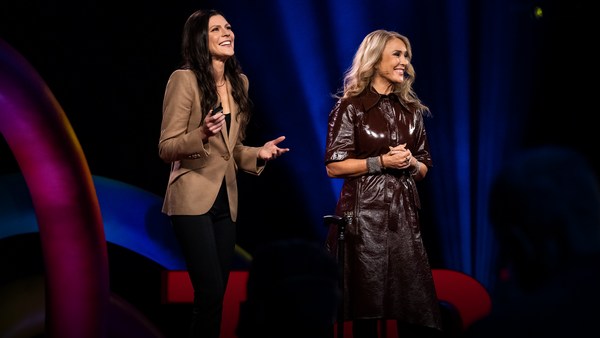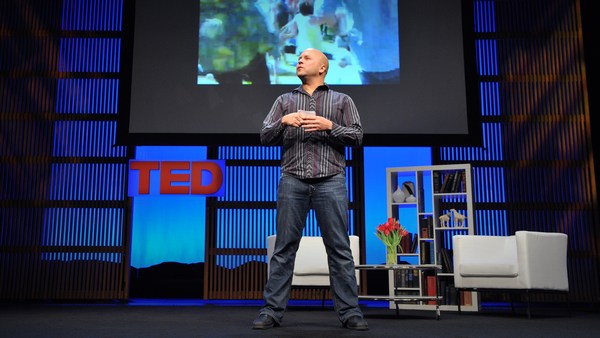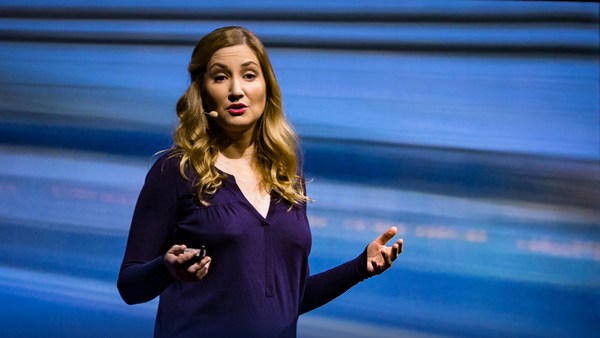Before I start, I'd like to know who's in charge today? Is it me? Is it you? Is it someone behind the curtain?
My point is, we think of leadership as a role for the few and the rest get to just lean back. Now, that, of course, might be OK for an event like this, but I believe that leadership by the few, it's not going to help us solve the problems ahead. These problems are complex and coming at us faster and faster. So we really need to get many minds together, more resources, more capabilities, and we need to do it effectively and sustainably.
What if leadership could be for the many? That's scary. And for all you leaders out there thinking it won't work, maybe in some cases it won't. But when it does, we have better outcomes and happier people, with everyone leaning in, even if just a bit more.
I'm a physicist turned management consultant working with global companies on strategy, artificial intelligence and digital transformation. I'm trained as an engineer, so when I started in this job, everything was new to me. And I have to admit something. At work, whenever a task is my idea, I do it a bit better than when it's someone else telling me.
(Laughter)
Unless, of course, it's my boss. Then I might feel like slowly proving it doesn't work.
(Laughter)
Being curious and complacent, I often ask: Why do we do things this way? Most times I do find good answers, but whenever the answers seem outdated, I try to come up with new solutions. Like with leadership.
A typical view of leadership is a hierarchical organization chart. Either you're a leader or you're not. Most people are being led, not taking lead. Communication often flows from top to bottom along just one line, which means it doesn't match the complexity of problems which move in several directions at once. Decisions are left to one person, the leader, who, being only human, can become a bottleneck of speed and scale. They can miss new ideas, diverse capabilities and potential that exist all over the chart.
So in a network instead, everyone's in charge and we replace power of the few with influence of the many. Sure it looks more messy, but I'd argue more beautiful, more multi-dimensional, more dynamic, more like nature. I believe this model can help us do more and be less dependent on each individual. Which means it’s resilient, and progress is sustainable.
To empower many more to lead, to move leadership from the few to the many, we each need to let go of a bit of power. Now that's uncomfortable. So let's talk about how.
The first thing we can do is remove labels. Now, imagine your co-worker, Lin, says "We need creative input."
And Joe goes, "Let's ask accounting."
(Laughter)
Said no one, ever.
(Laughter)
But maybe we should. Labels take many forms and shapes like functions, titles, genders, nationalities, educational backgrounds. They are everywhere and help us recognize things. And sometimes we even work hard to get that label, so they are comfortable. But labels come with a high cost of boxing people in, not enabling us to grow outside those boxes. We need to think about diverse skill sets and perspectives as we set teams. But once we have, what if you for a second forgot who's from marketing or who's the data scientist or who's the leader? I have at least been amazed by surprising capabilities in our teams. You don't know what you don't know. Well, you also don't know what others know. Accounting might actually have a great marketing idea.
Now that we have gotten rid of those labels, I have another uncomfortable idea for you. Share everything. We've learned to share a lot of things like rides, scooters, even our homes. But when it comes to work, we so often end up sitting on information and resources for ourselves. And have you ever thought to yourself: “I can’t ask that, it’s too stupid?” Yeah? Or maybe you've tried withholding information thinking it would give you an advantage?
(Laughter)
Or, you know, the feeling of, "Had I just known that, I would have done so much better." Let's imagine a team working together on a green transition strategy, and the following conversation is inspired by a team I was part of. And Amine says he's working on a list of emission reduction levers. He's stuck, asking for help. Isabelle goes, "Do you have this data set?" Lisa: "Oh, stated something similar. Shall we combine?" Peter: "Another market worked on this - did you meet?" This is leadership. Not in the hierarchical sense, but in the sense of taking lead for solving a problem by listing questions and involving people. Leadership is not about giving answers. It is asking the questions. It is daring to show vulnerability.
Information is power and information is everything, like questions, but also data, context, emerging insights, work in progress, even water cooler conversations. Sharing means less one-on-one communication, much more crowdsourcing and co-creation in the open, transparent space, real time. And with more upheaval than you might naturally think of.
Wait. Doesn't that get really messy, even chaotic? Well, we are used to information overload already. I’m guessing you don’t read everything on social media, and you know quickly how to navigate your way to what's relevant to you. And if you catch yourself thinking, “I can’t share that,” I want you to test again and ask, why? Because the upside of sharing everything is huge. We can leverage the power of the crowd much better when we all have context. It's faster due to less waste and duplicate work and conflicting input in one-on-ones. But also because we can parallelize work and not just work sequentially. It drives better quality when we capture ideas day and night and when we distribute quality assurance across the full team. But the best of it all, we get greater ownership through early involvement of people like customers and stakeholders, avoiding that classic show-and-tell, the one-way presentation.
You can probably tell I could go on and on, but there is one more uncomfortable thing we have to do. Be nice to each other.
(Laughter)
Kindness. Sure, you say. But in the moment, isn't it easier throwing someone else under the bus? And have you tried the opposite of kind, the unkind leader, the one who happily shares blame but not shine? Or the pretend kind leader. Like, “I know it’s Friday afternoon, and I need this by Monday 8 am. But don't spend your weekend on it."
(Laughter)
Kind or unkind becomes especially clear when someone makes a mistake. Now take Sara, she spotted a mistake, a quite significant one. Now Sara is brave and shares that instantly with the full team. Wow, the replies.
Bharat goes, "Thanks for sharing. That takes courage."
Samuel, "Better now than never."
Jenny, "No mistakes would mean we weren't moving fast enough."
The formal leaders in this conversation, they didn't think much about it when this happened, but the team members have later come back and said that this was a truly defining moment for the team culture. They felt safe, a sense of growth mindset and trust that we have each other's back. The team members also encourage each other, whether it's "love it," "spot on" or cute emojis. This matters. People so often roll their eyes when we talk about kindness, but even small words go a long way. This doesn't mean lowering the bar or avoiding difficult conversation. In fact, kindness allows us to take up even trickier topics.
And the results? Well, good projects deliver on time as expected. Honestly, I think we all know projects that really don't. But by removing labels, sharing everything and being kind, you started seeing a spike. Though more bumpy, we now get exponential growth. Results are much better and unexpected. Like the team I introduced you to. People couldn't believe the impact and ownership we created. In just eight weeks. And we've seen this across many different problems and very different desired outcomes. Changing how we work, we found amazing results. Even early on in pilots, 80 percent of our people said they experienced more value delivered. Sixty percent found better individual sustainability, work-life balance. And this is in a company known for high-performing teams.
When everyone is a leader, it allows us to do more and do it better. Now imagine we took the formal leader out of the team. That's in fact, what happened as I went on maternity leave a few months back. Nothing happened. The team just went on. Even this talk, I didn't come up with the ideas on my own. Many people did. It was crowdsourced and co-created from day one.
Distributed leadership is a movement that goes beyond the traditional leader. People are much more likely to do things if they feel a sense of ownership and "it was my idea" versus being told what to do. We need to create leaders, not followers.
Now, none of this is magic, but it won't happen if traditional leaders block it. We can't afford having anyone sitting back these days with complex problems coming at us quickly and constantly. We need to tap into everyone's knowledge and creativity. Labels and hierarchies, hiding information, consolidating power, being unkind or pretend kind. That's not going to help us do what we need to to create a better future.
So when I now ask you, who's in charge, who’s the leader today? I want you all to raise your hands.
(Laughter)
Yes, you.
(Laughter)
Thank you.
(Applause)





